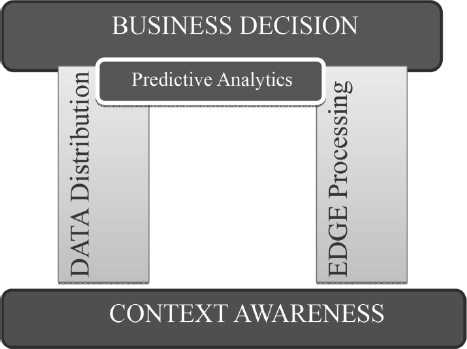4
RFID Markets
Which business problems can RFID technology resolve? This is this key question that this chapter will try to answer
4.1. Introduction
The Internet of things (IoT) is emerging, and it will create a smarter world with objects connected to their environments and also to all of us.
There will come a day when a massive network of small intelligent devices will be aware of our needs and work for our actual benefit.
A number of technologies will enable IoT to be deployed widely, and the item-level RFID is a key technology that has already conquered a few applications.
To date, RFID has been used mainly for business-to-business (B2B) applications, but business-to-consumer (B2C) applications have started emerging with near-field communicating (NFC) already turning hundreds of millions of mobile phones into RFID readers.
The tipping point for RFID wide deployment is that consumers are using the technology for their own benefits.
4.2. Market inflection point: users
Although history never repeats itself the same way, it is possible to highlight some analogies between mobile phone, Internet and RFID.
In the early 1970s, the first e-mail was sent and the first handheld mobile phones appeared.
From there, it took 25 years to build a reliable infrastructure and another 5 years to build user-friendly tools. Also, when users start experiencing the importance of the technology to make their life simpler, this is the inflection point for fast technology deployment.
Figure 4.1.

RFID is not yet widely used, but it is heading toward this ultimate point.
4.3. RFID: what for?
An RFID user can enjoy the benefit of driving without stopping at the RFID toll collection and paying “on the fly” with RF when very long queues line up at the toll collection booths with cards and cash (see Figures 4.2 and 4.3).
RFID enables instantaneous and automatic transactions at a distance.
Figure 4.2. Jammed toll collection

Figure 4.3. Fluid RFID driveway
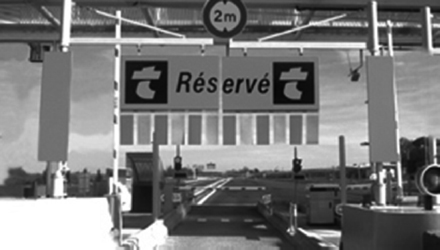
RFID can have more applications. It can also process multiple items at a time with several hundred per second, without line of sight (RF goes through many materials), with no battery and at extremely low cost. All these features enable an item-level RFID (see Figures 4.4 and 4.5).
Figure 4.4. RFID cabin with up to hundreds of tags in a trolley
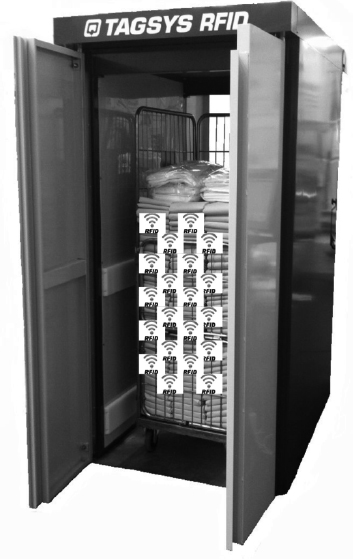
Figure 4.5. RFID manual reader with up to hundreds of tags in a case

4.4. Open- and closed-loop applications
4.4.1. Closed-loop applications
In the closed-loop applications, the item cycles again and again (see Figure 4.6). Examples of this application are:
A service company buys items and services them. The user utilizes the item, and the owner buys and services the items when cycling them back (washing textile, filling up gas cylinders, etc.).
4.4.2. Open-loop applications
In the open-loop applications, the items go in a straight line, as shown in Figure 4.7.
The supply chain is a good example of an open-loop application. It goes from production up to point of sales with billions of items manufactured mainly in Asia and transported to the stores all over the world for consumers to buy. RFID is used along the supply chain enabling a reliable logistics process.
Figure 4.6. Closed-loop application
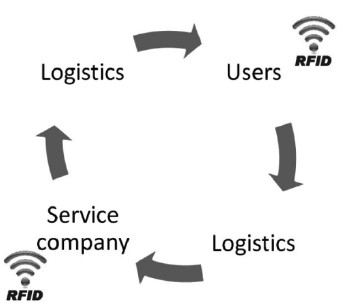
Figure 4.7. Open-loop application

4.5. RFID return on investment
4.5.1. Introduction

Return on investment (ROI) is at the heart of the RFID buying decision process. RFID technology must generate an ROI to trigger the associated investment.
In general, the RFID ROI is built on the cost reduction and sales increase, both generating a global ROI.
Handling millions of items moving across the world is a difficult exercise, for example, our personal laundry at home with a few hundreds of items only … but it is still a headache to pair socks (see Figure 4.8).
Figure 4.8. Laundry at home, a headache

Although there are many barcode systems already in place to manage the flow of items, the gap between “which items are supposed to be there” and “which items are physically there” is significant.
RFID answers the question “which items are physically there” fully automatically and instantaneously.
Fully automatically and instantaneously: professionals use RFID to automate production, distribution center (DC) and stores. Compared to barcodes, it is of course more improved in speed and accuracy, but it can be more than that: it enables operations that were impossible before, such as:
Fully automatically and instantaneously: users can very simply make it intuitive, enabling self-service kiosks such as:
4.5.2. Cost reduction
There are many sources of cost reduction with RFID:
4.5.3. Sales increase
4.6. Many RFID technologies
There are several RFID frequencies:
On top of the frequency, RFID can be passive, battery-assisted passive (BAP) or active:
RF sensing: RFID can be limited to the transmission of an ID, which is the case for most applications today. RFID can also measure physical parameters (temperature, pressure, heart beat, etc); in that case, RFID turns into RF sensing.
4.7. Examples
There are numerous RFID applications.
Let us briefly present the key applications:
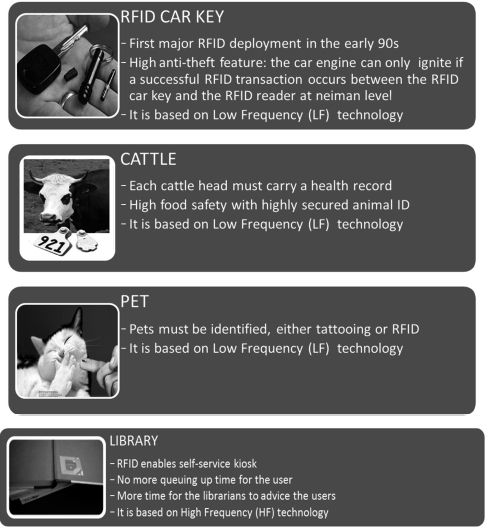



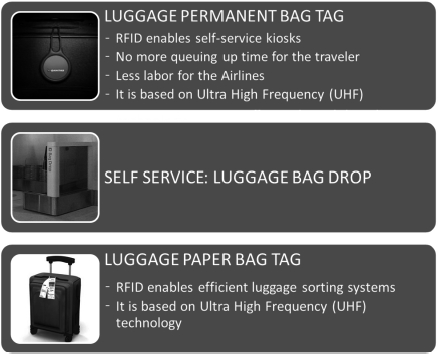

4.8. Next RFID: product-embedded and seamless infrastructure
4.8.1. Introduction
The fashion apparel retailers are driving the large adoption of UHF RFID. It started in 2005 with Mark & Spencer in the UK with the first significant volumes (100 Mu/y), and it is deploying further right now with the US retailers, hitting larger volumes (2,000 Mu in 2013).
4.8.2. RFID: “Slap and Ship”
As of today, RFID for retailers is named “Slap and Slip” (Figure 4.9):
There is no use of RFID beyond the point of sales, which means no customer interaction.
Figure 4.9. Slap and Ship
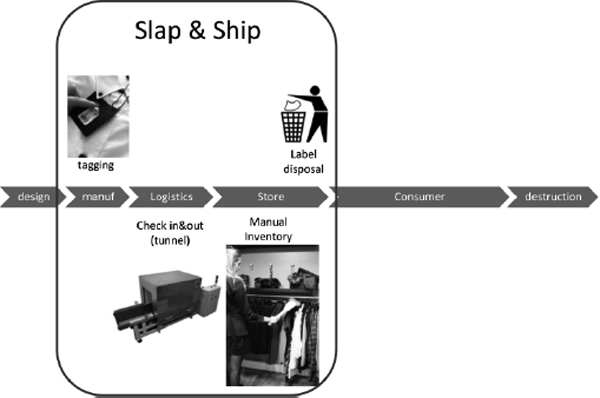
4.8.3. Next RFID: from cradle to grave
Next RFID will be used throughout the whole product life, from cradle to grave (see Figure 4.10).
It will require:
4.8.4. Embedded RFID
4.8.4.1. Key constraints
Embedded RFID is a much more complex operation than just applying a hanging label onto a product.
The process must start right at the beginning of the product design to incorporate RF constraints and finally get a high-performing RFID.
Integrating an RF antenna into a product requires specific design rules as the product itself becomes part of the RF antenna.
Figure 4.10. Full lifecycle
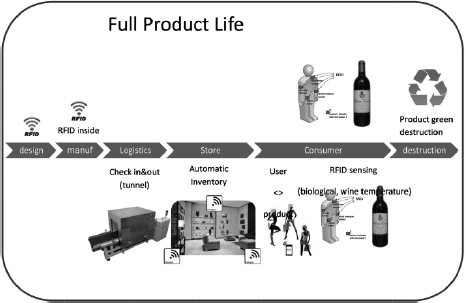
Key constraints are:
Figure 4.11. RFID range versus tag size
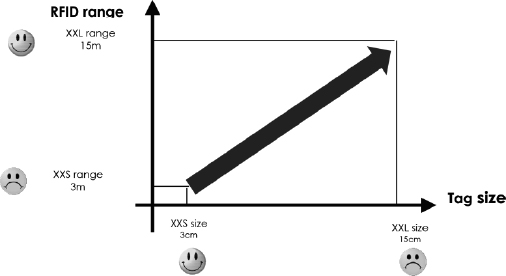
4.8.4.2. A smart embedded RFID solution
At this point, let us mention the smart concept named Stiletto, which was developed by TAGSYS, to dramatically simplify the embedded RFID.
Figure 4.12. Very small tag

Figure 4.13. Ruggedized and flexible tag

4.8.4.3. Some practical examples
1) Textile tag: the RF antenna is made from a metalized thread woven into fabrics; it zigzags a little bit to reduce to overall 15 cm length. The tag, MuTRAK, is positioned in the middle of the RF antenna. The textile tag is very rugged, it survives laundry cycles and it is also fully flexible and therefore totally transparent to the wearer. It provides a range of 5 m.
Figure 4.14. Textile tag

2) High-heel shoe tag: the RF antenna is made from the metal stiffener inside the shoe. The tag, MuTRAK, is integrated into the shoe sole in the middle of the metal stiffener. It provides a range of 5 m. This is an example where the RF antenna is found in the item itself (see Figure 4.14).
Figure 4.15. Shoe tag

3) Bottle of wine: the RF antenna is made from the metal foil on top of the bottle and the tag is positioned tangent to it. It provides a range of 3 m. This is an example where the RF antenna is found in the item itself (see Figure 4.15).
4) Bra: the RF antenna is made from the metallic whalebone of the bra. The tag is positioned in the middle of the metallic whalebone. It provides a range of 5 m. This is an example where the RF antenna is found in the item itself (see Figure 4.16).
Figure 4.16. Bottle tag
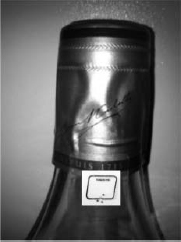
Figure 4.17. Bra tag
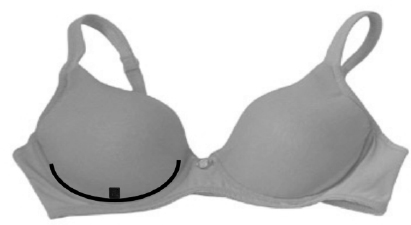
4.8.4.4. RF Sensing
The RF antenna is of course the heart of the RF communication.
The RF antenna can have many applications. It can also tell us about the physical parameters of the item that it is applied to. Indeed, the RF antenna is sensitive to the medium it is applied to, and the medium can itself be sensitive to the physical parameters, such as temperature, pressure and humidity.
Therefore, RF sensing enables access to the physical parameters with no extra tag component and therefore no extra cost. Examples of this include human body temperature and heartbeat, and maximum storage temperature of a wine bottle (see Figures 4.17 and 4.18).
4.8.5. Seamless and ubiquitous infrastructure
Embedded RFID turns items into “smart items” for their whole lifetime.
Similarly, reading devices, whether mobile or fixed, will improve to become fully non-intrusive.
Figure 4.18. Human heart beat and temperature
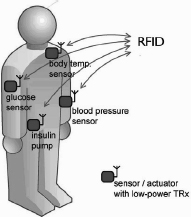
Figure 4.19. Storage temperature of wine bottle

For user interaction, the mobile phone is of course the best platform (see Figure 4.19). As of today, NFC standard integrates the HF technology. UHF is likely to be integrated into NFC standards in the mid/long term.
Figure 4.20. UHF NFC phone
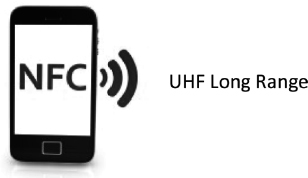
As of today, RFID-fixed antennas are pretty bulky and 100 of them are required to cover a whole store area and perform store automatic inventory. For the fixed reading infrastructure to become seamless and ubiquitous, RF technology must leapfrog on two fronts:
Figure 4.21. Seamless and ubiquitous infrastructure
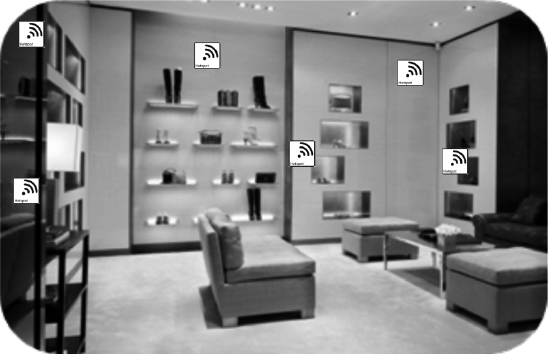
4.8.6. Software for business decisions
4.8.6.1. Introduction
There will come a day when a massive network of small intelligent devices will be aware of our needs and work for our actual benefit. Of course, we have not reached it, but the trend is in the right direction.
The physical world with RFID devices will generate a lot of RFID events, themselves creating the context.
From this context awareness, the logical world will provide answers to the following questions: how to react to this context? How to make the right business decisions?
4.8.6.2. ePCGlobal middleware
In the mid-2000s, ePCGlobal standardized the RFID middleware, inspired by the functioning of the Internet, with the following:
Very few ePCGlobal middlewares have emerged due to the overall system inadequacy.
4.8.6.3. Next RFID middleware
One complexity is coping with the huge quantities of events generated by the RFID. It starts with edge processing to keep only the pertinent data. Then, the data must be kept close to the decision point.
Finally, predictive analytics, needed to take the right decision, must combine real-time and historical data (see Figure 4.21).
Figure 4.22. Next RFID middleware
